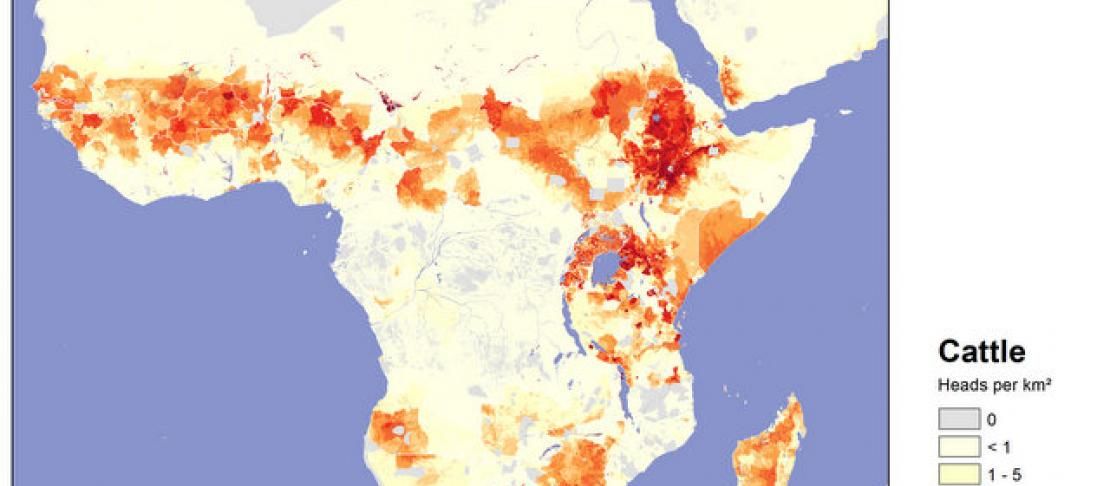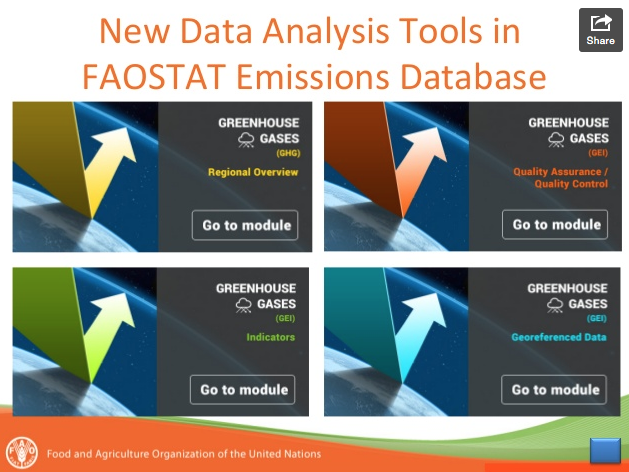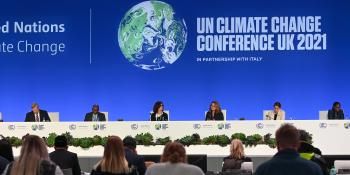Lower cost greenhouse gas emission estimates for agriculture

Scientists are collaborating to furnish national governments with reliable and affordable methods for estimating greenhouse gas emissions from agriculture, informing climate-smart agriculture and low-emissions development.
Country representatives and leading scientists met at the Food and Agriculture Organization of the United Nations (FAO) in November to identify how to reduce the cost of estimating greenhouse gas emissions from agriculture. The workshop was organized by the CGIAR Research Program on Climate Change, Agriculture and Food Security (CCAFS) and the Mitigation of Climate Change in Agriculture (MICCA) Programme of FAO.
The demand for improved emissions data is growing across the globe.
Vietnam has set a goal, as part of our green growth strategy, to reduce the intensity of greenhouse gas emissions by 8 to 10% by 2050, compared to 2010 levels. In the agriculture sector, we want to increase agricultural production by 20% and reduce emissions and poverty by 20% by 2020. We need to be able to measure our progress”, said Mai van Trinh, Deputy Director General at Vietnam’s Institute for Agricultural Environment.
Reducing the cost of agricultural greenhouse gas quantification is critical to identify climate-smart priorities and to support measurement, reporting and verification related to Biennial Update Reports (BURs) and Nationally Appropriate Mitigation Actions (NAMAs). Climate-smart agriculture increases productivity and incomes, adaption and resilience to climate change, and reduces and/or removes greenhouse gas emissions wherever possible.

Links to all presentations, including this slide from Francesco Tubiello of FAO, are available at the end of this article.
Challenges to estimating and monitoring emissions
Collecting data on farm activities, making measurements to establish emission factors, and establishing national systems for compiling and analyzing data are expensive, and uncertainties in current data remain high. In response, country representatives identified several key challenges to agricultural greenhouse gas accounting in developing countries.
Poor or insufficient data on agricultural activities: Countries need multiple kinds of data in order to estimate emissions, but these are often not available. For example, agricultural ministries may have national statistics on fertilizer imports and exports, but little data on crop-specific fertilizer use and area under each crop—necessary pieces of information for estimating emissions from fertilizer use.
Lack of emission factors: Emission factors are values that are used to relate a greenhouse gas-generating activity (such as cattle production) with the quantity of a greenhouse gas released into the atmosphere. Such values are specific to particular environments and management systems, and they are often unavailable for developing country conditions. The relationship between activities and emissions can also be quantified using complex models, but both approaches require numerous field measurements to calculate emission factors or calibrate and validate models. There is particular scarcity of data on livestock systems.
Access to data and coordination: Information on agricultural activities is sometimes collected by multiple institutions for their own uses. According to Michael Phiri, Monitoring and Evaluation Specialist at the Zambia Environmental Management Agency:
Data sharing becomes a challenge because the data are in formats that are not compatible, or different ministries collect the same information but their statistics conflict each other. Then, which version should be used?”
A preliminary action plan for reducing costs
Workshop participants developed action points for reducing the cost of greenhouse gas emission estimates in different agriculture sectors.
Incorporate climate-relevant data into agricultural censuses and surveys: Integrating GHG-relevant information into agricultural censuses is an efficient way to collect such data. This may become standard in 2020 census rounds, as FAO has just developed a new module for GHG-relevant data within the World Census of Agriculture. Look for the module to be published soon. Such data can also be included in other national surveys; George Phiri, Coordinator of FAO’s Climate-Smart Agriculture project in Malawi, described in his presentation how Malawi’s National Statistics Office has incorporated questions on land management into its Integrated Household Survey.
Outsource data collection to the crowd: New applications such as Geo-Wiki ask people to interpret visual images in order to improve land cover data. With the spread of texting and smartphone technology in developing countries, such “citizen science” approaches have big potential. Other applications such as Collect Earth combine freely available visual data from NASA and USGS with cloud-based processing services like Google Earth Engine to allow desk-based data collection by in-country experts.
Integrate measurements and modeling: Models are key to estimating emissions without the need for direct measurement, but models need to be validated and calibrated to local conditions. Researchers undertaking measurements could collect auxiliary data such as rainfall, temperature, and crop performance to support models. Klaus Butterbach-Bahl described guidelines for selecting auxiliary variables when measuring greenhouse gas emissions from soils. Models can be used to identify areas of greatest uncertainty in order to prioritize measurements.
Target measurements to maximize usefulness: In addition to prioritizing based on areas of greatest uncertainty, targeting key farming systems and practices and using statistical sampling to efficiently capture information can reduce data needs.
Mauricio Chacon, coordinator of Costa Rica’s NAMA for livestock, described the approach he and his colleagues used:
We developed 17 clusters of livestock systems according to agro-ecological zones and animal management, and these clusters explain most of the variability in emissions. Now we can develop emission factors for these clusters, and not spend money on unnecessary measurements. We also reduced the uncertainty of estimates, because for each cluster we could describe in better detail the feeding and management of the animals.”
Improve use of global databases for emissions: Stephen Ogle of Colorado State University suggested that an expert group could support data synthesis and modeling from existing literature. This would generate much-needed additional emissions factors for more locations and management practices. Further, people conducting measurements and calibrating models should make concerted efforts to share their information in platforms such as the Emissions Factor Data Base (EFDB) and Global Research Alliance Modeling Platform (GRAMP) so it can be used at national, sub-national and international levels.
Build the right capacities: “We always just say ‘we need more capacity’! But we need the right capacity,” several workshop participants emphasized. Developing countries need not only training, but also long-term mentoring and follow-up. Capacity is needed locally for field data collection, and nationally for identifying relevant tools, analyzing and interpreting data, and modeling.
Link adaptation and mitigation to motivate action: Participants repeatedly emphasized that there are complementarities between adaptation- and mitigation-related information. Explicitly linking the two can both reduce data needs and provide incentives for action.
Workshop participants committed to furthering these initiatives, and CCAFS and FAO will use this information to inform policies, protocols, and decision-making. The action points were further discussed at an FAO-IPCC-IFAD expert meeting on use of FAO data and IPCC GHG inventory guidelines for agriculture and land use, held immediately following at FAO. A complete set of action points, video interviews, and progress made to date will be released in a forthcoming workshop report. More information about the workshop is available from FAO-MICCA.
Presentations
Challenges for agricultural greenhouse gas quantification
- Challenges for agricultural greenhouse gas quantification. Fahmuddin Agus, Indonesian Soil Research Institute
- GHG emission in agriculture in Vietnam. Mai van Trinh, Institute for Agricultural Environment, Vietnam
- GHG estimations for agriculture in Kenya. Michael Okumu, Ministry of Agriculture, Livestock and Fisheries, Kenya
- GHG inventory in Zambia. Michael Phiri, Zambia Environmental Management Agency
Emissions data guidelines of UNFCCC and climate finance mechanisms
- UNFCCC inventory reporting needs, collecting data and using this information to inform nationally appropriate mitigation actions (NAMAs) and low-emissions development strategies (LEDS). Stephen Ogle, Colorado State University, USA
- GHG accounting methods and requirements for Global Environment Facility projects. Ulrich Apel, Global Environment Facility (GEF)
- Clean Development Mechanism methodologies for the agriculture sector. Kenjiro Suzuki, United Nations Climate Change Secretariat
Innovations that decrease the costs of collecting biophysical and activity data
- Refining estimates with national survey data: example of the Malawi Integrated Household Survey. George Phiri, Food and Agriculture Organization Office, Malawi
- Collect Earth: multi-purpose land monitoring. Remote sensing activity data: Open Foris suite Alfonso Sánchez-Paus Díaz, FAO
- Using new soil data products for GHG estimation. Freddy Nachtergaele, FAO
- Informed sampling for testing mitigation options to reduce costs. Mariana Rufino, Center for International Forestry Research (CIFOR), Indonesia
- Potential for crowdsourcing and using mobile phone technology. Linda See, International Institute for Applied Systems Analysis (IIASA), Austria
- Approaches to activity data collection in livestock systems. Ed Charmley, Commonwealth Scientific and Industrial Research Organisation (CSIRO), Australia
Available emission factor data and low-cost methods for greenhouse gas data estimation
- FAOSTAT emissions database: available data and major gaps. Francesco Tubiello, FAO
Methods for low-cost field measurement
- Soil carbon stocks and changes: Land Degradation Surveillance Framework. Vince Lang, Szent Istvan University, Hungary
- Quantifying greenhouse gas emissions from managed and natural soils. Klaus Butterbach-Bahl, International Livestock Research Institute (ILRI), Kenya
- Developing country-specific emission factors for livestock systems in Colombia. Edgar Cardenas, Universidad Nacional de Colombia
Tool bazaar
- Global Livestock Environmental Assessment Model – GLEAM. Carolyn Opio, FAO
- CCAFS-MOT: a decision support tool for geographic optimisation of agricultural mitigation options. Diana Feliciano, Jon Hillier, Sylvia Vetter, University of Aberdeen, UK
- EX-ACT introduction and training. Louis Bockel, FAO
Workshop Report
See the summary workshop report here.



